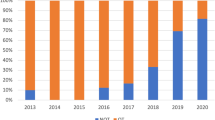Abstract
It is unknown whether noncomplicated acute appendicitis cause bacterial translocation. In this study, we aimed to test development of the bacterial translocation in the patients who were operated for acute appendicitis. In this prospective study, 10 control patients who underwent elective operations because of other reasons, and 18 patients with noncomplicated acute appendicitis were evaluated. No patients took prophylactic antibiotic. After laparotomy, samples were obtained from peritoneal leaf just close to wound edge, and peritoneal swab culture from right paracolic region. Before appendectomy, a mesenteric lymph node (MLN) adjacent to the terminal ileum was taken out. Tissue samples were placed in a sterile container for microbiological analysis, and 10% formalin for histopathological analysis. Control samples had no bacterial translocation. Only 3 of 18 (16.6%) patients with appendicitis included bacterial translocation to MLN. There was no significant difference between both groups. No bacterial colonization was detected in the peritoneal tissue and peritoneal swab culture. Peritoneal tissue injury score was 2 ± 1.4 in controls and 2.8 ± 1.7 in the patients with appendicitis (P > 0.05). MLN injury score was 2.5 ± 1.3 in controls and 3.2 ± 1.5 in the patients with appendicitis (P > 0.05). No patient developed wound and systemic infection. No significant bacterial translocation frequency and tissue injury score was identified in the children with noncomplicated acute appendicitis. This result suggests that antibiotic prophylaxis may be unnecessary in such patients.
Similar content being viewed by others
References
Berg RD, Garlington AW (1979) Translocation of certain indigenous bacteria from the gastrointestinal tract to the mesenteric lymph nodes and other organs in a gnotobiotic mouse model. Infect Immun 23:403–411
Wells CL (1990) Relationship between intestinal microecology and the translocation of intestinal bacteria. Antonie Van Leeuwenhoek 58:87–93
Berg RD (1995) Bacterial translocation from the gastrointestinal tract. Trends Microbiol 3:149–154
Stringel G (1987) Appendicitis in children: a systematic approach for a low incidence of complications. Am J Surg 154:631–635
David IB, Buck JR, Filler RM (1982) Rational use of antibiotics for perforated appendicitis in childhood. J Pediatr Surg 17:494–500
Busuttil RW, Davidson RK, Fine M, Tompkins RK (1981) Effect of prophylactic antibiotics in acute nonperforated appendicitis. A prospective, randomized, double-blind clinical study. Ann Surg 194:502–508
Andersen BR, Kallehave FL, Andersen HK (2003) Antibiotics versus placebo for prevention of postoperative infection after appendicectomy. Cochrane Database Syst Rev CD 001439
Gorecki WJ, Grochowski JA (2001) Are antibiotics necessary in nonperforated appendicitis in children? A double blind randomized controlled trial. Med Sci Monit 7:289–292
Kizilcan F, Tanyel FC, Buyukpamukcu N, Hicsonmez A (1992) The necessity of prophylactic antibiotics in uncomplicated appendicitis during childhood. J Pediatr Surg 27:586–588
Andersen BR, Kallehave FL, Andersen HK (2001) Antibiotics versus placebo for prevention of postoperative infection after appendectomy. Cochrane Database Syst Rev CD001439
Ein SH, Sandler A (2006) Wound infection prophylaxis in pediatric acute appendicitis: a 26-year prospective study. J Pediatr Surg 41:538–541
Pettigrew RA (1981) Delayed primary wound closure in gangrenous and perforated appendicitis. Br J Surg 68:635–638
Emil S, Laberge JM, Mikhail P, Baican L, Flageole H, Nguyen L, Shaw K (2002) Appendicitis in children: a ten-year update of therapeutic recommendations. J Pediatr Surg 37:1317–1320
Yao Y, Bahrami S, Leichtfried G, Redhl H, Schlag G (1995) Pathogenesis of haemorrhage-induced bacteria/endotoxin translocation in rats. Effects of recombinant bactericidal/permeability-increasing protein. Ann Surg 221:398–405
Sedman PC, Macfie J, Sagar P, Mitchell CJ, May J, Mancey-Jones B, Johnstone D (1994) The prevalence of gut translocation in humans. Gastroenterology 107:643–649
O’Boyle CJ, MacFie J, Mitchell CJ, Johnstone D, Sagar PM, Sedman PC (1998) Microbiology of bacterial translocation in humans. Gut 42:29–35
Gilmore OJA, Martin TDM (1974) Aetiology and prevention of wound infection in appendectomy. Br J Surg 61:281–287
Acknowledgments
This paper was supported by Akdeniz University Management Unit of Scientific Projects. Also, we thank all staffs in the department of pediatric surgery, in the operating room and in the Microbiology laboratory.
Author information
Authors and Affiliations
Corresponding author
Rights and permissions
About this article
Cite this article
Aslan, A., Karaveli, Ç., Ogunc, D. et al. Does noncomplicated acute appendicitis cause bacterial translocation?. Pediatr Surg Int 23, 555–558 (2007). https://doi.org/10.1007/s00383-007-1899-5
Accepted:
Published:
Issue Date:
DOI: https://doi.org/10.1007/s00383-007-1899-5




